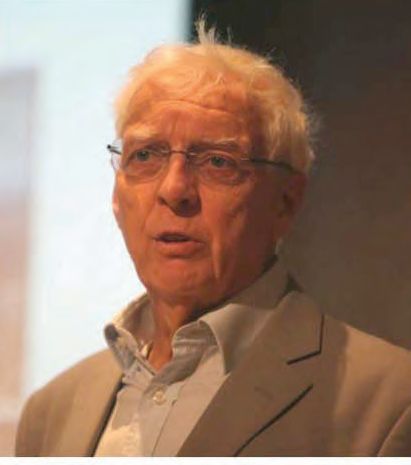
Physiology News Magazine
Brain-Heart Interactions in Health and Disease – a symposium in honour of John Coote
Events
Brain-Heart Interactions in Health and Disease – a symposium in honour of John Coote
Events
Thelma Lovick
University of Bristol, UK
https://doi.org/10.36866/pn.93.21
21 July 2013, Austin Court, Birmingham, UK

Those of you who know John Coote, his work and his prestigious and continuing publication output, may be surprised to learn that it is 10 years since his ‘retirement’. John has devoted his entire career to physiology via his research interests in the functioning of the autonomic nervous system in health and disease as well as via his teaching. He continues to collaborate actively with research groups in Birmingham, Leicester, Durham, UCL and Oxford and maintains contact with colleagues worldwide.
John has spent 45 years at the University of Birmingham where, following retirement from Head of Department of Physiology in 2003, he now holds the position of Professor Emeritus. It was therefore fitting that more than 130 friends and colleagues from around the globe converged on Austin Court, an attractive canal-side venue in Birmingham city centre, on the day prior to IUPS, in order to honour him and his contribution to physiology.
The theme of the meeting was Brain-Heart Interactions in Health and Disease. Mike White (Birmingham), Roger Hainsworth (Leeds) and James Fisher (Birmingham) started off the day with presentations on the role of muscle afferents, cardiac and pulmonary vascular receptors on different aspects of cardiorespiratory control, drawing from experimental work on animals and humans. The focus then shifted from afferent to efferent regulation when John Townend (Birmingham) described work on the beneficial effects of physical activity and vagal control in humans. A lively presentation by Andre Ng (Leicester) then showed how the innervated in vitro heart preparation has been used to great effect in his lab to uncover exciting new developments in the role of nitric oxide in vagally mediated actions on cardiac function.
Moving to the realms of central nervous control of the heart and pathophysiological states, Susan Pyner (Durham) described her work on the anatomical connections of the paraventricular nucleus, and how this circuitry might be implicated in heart failure. Edward Johns (University College Cork) then directed our attention to the cardio-renal axis and how the nervous control of the kidney can play a significant role in the development of hyper-tension as well as kidney failure. Thelma Lovick (Bristol) showed how the autonomic effects of localised stimulation in the brains of animals are now being translated into the clinical situation; this offers the potential for developing deep brain stimulation in humans to modulate autonomic dysfunction to therapeutic advantage. To close the proceedings David Cechetto (University of Western Ontario) described his studies into the role of the cerebral cortex on cardiac autonomic control which have utilised recordings from sites in various cortical regions of experimental animals and man as well as brain imaging techniques. These studies have shown the importance of the insula, the cingulate and prefrontal cortex in cardiac control.
When the formal proceedings had come to an end the party moved for a drinks reception to nearby Bank Restaurant, followed by a convivial dinner and much lively discussion and ‘catching up’ between friends old and new. The proceedings of this memorable meeting will be published as a special edition of Experimental Physiology in early 2014.
The organizer wishes to acknowledge the generous support for the meeting from The Physiological Society, Experimental Physiology (Wiley) and the British Heart Foundation. Thanks also to Kieran Brack, Mary Keen, Zsuzsanna Molnár, Atif Sagir, Attila Sik, and James Winter for their help with the organisation.
